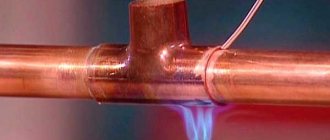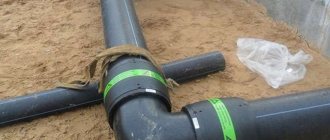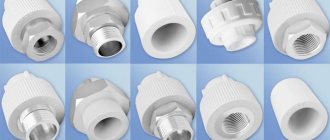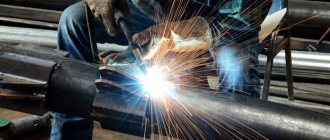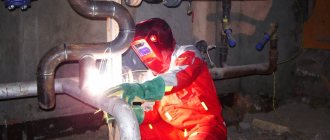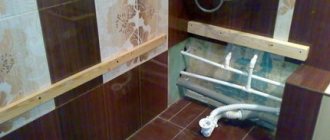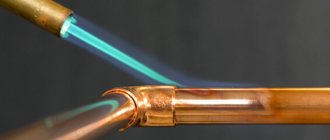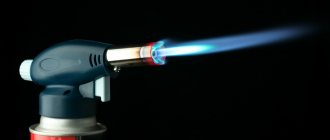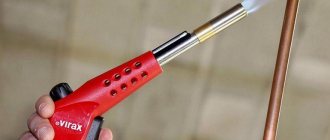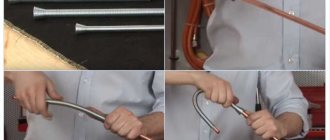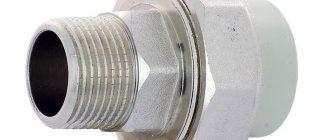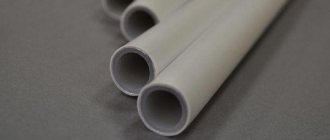Do you want to repair or replace communications made of polymer pipes? Agree that it’s not a bad idea to save on calling a technician by assembling a new pipeline yourself. But you don’t know how you can connect the individual elements of the system to each other and what you will need for this.
The article we presented describes in detail the technology of welding polypropylene pipes - any novice plumber can connect them with his own hands. We will tell you what you need to consider, how to use a soldering iron to join plastic elements. We will tell you in what cases other methods are used.
To help the novice master, we have selected detailed videos demonstrating the step-by-step process of welding polypropylene, and photo illustrations.
By the way, you can do not only plumbing or heating, but also a lot of necessary and useful things
Soldering technology
When heated, polypropylene becomes soft, resembling plasticine in consistency. Particles of liquid material mutually penetrate into the adjacent part. After cooling, it hardens and becomes resistant to tearing. The cooled seam is not inferior to the base material in technical parameters. To ensure a quality connection, it is recommended to meet the following conditions:
- polypropylene is heated with the device to a state of viscous fluidity, following the instructions in the instructions for the equipment;
- solder products from the same material, you should not connect polypropylene parts with different markings, the strength of the connection will be impaired;
- the ends and fittings are joined tightly, avoiding gaps and distortions; a tight fit is ensured by sanding the cut edge of the pipes with sandpaper;
- polypropylene hardens quickly, leveling is possible within a few seconds, after hardening it will be impossible to correct the defect.
Iron for welding pipes Source nehomesdeaf.org
Thanks to the thermoplastic characteristics of polypropylene, reliable joining of elements is ensured.
A strong seam is obtained only if welding technology is followed and quality materials are selected. Let's look at how to solder polypropylene pipes below. On devices that support the installation of several nozzles, the sleeve can be installed in a convenient position. The location of the heating cartridge does not affect the quality of heating.
Secrets of high-quality pipe welding
In order for the soldering of heating pipes to be of high quality and the connection to be flawless, you need to know the small secrets of this process:
- The pipe should not enter the fitting when cold.
- The operation of attaching parts to the soldering iron is carried out simultaneously, with pressure, but without twisting.
- The parts are connected without unnecessary pressure and without twisting.
- The parts are kept in a fixed state until they cool completely.
- The result of a high-quality connection is a uniform influx of plastic along the diameter of the pipe near the fitting.
If you are going to solder heating pipes for the first time, then purchase a couple of cheap fittings and some pipe supply. Practice beforehand to feel and understand the physical qualities of cold and molten material. For self-control, cut your connection and look at the quality of the soldering from the inside.
Difficulty of welding
Test installation and connection of the first link of the system can be performed on a table or on the floor in a convenient place. Further welding on site is carried out under various technical conditions. Some areas of the system are difficult to access with an iron.
Before soldering pipes in hard-to-reach areas, it is recommended to choose a comfortable position. An inconvenient location causes delays in work and the appearance of various defects, for example:
- overheating of parts with melting of polypropylene and its spreading;
- the connection is deeper or smaller than required by the standard;
- installation with bending or rotating the element.
Installation of equipment on the platform Source static.onlinetrade.ru
When heating and connecting, synchronous actions should be observed: both parts are heated and removed from the nozzle at the same time. There is no delay before assembling heated parts. The pause occurs due to the need to place the device on the platform. Technical downtime directly depends on the experience of the technician and his speed of work. Errors in work lead to sagging, seam mixing, cracking and damage to the joint.
Security measures
When working with a heating device, it is necessary to observe personal protective measures:
- The soldering iron must be installed on a horizontal surface in a place free from materials.
- The technician must wear protective gloves (for working with hot tools) and comfortable overalls.
- Avoid bending over melting plastic as this process releases harmful fumes.
- The room should be relatively clean. The working surface is free from dust and debris.
- The connection between the soldering iron plug and the network must be tight and the cord must be loose.
We recommend that you familiarize yourself with: Flange adapter for connecting PE pipes
The welding tool is preheated for 20 minutes if it does not have a corresponding indicator.
Procedure for performing diffuse soldering
The ends are joined directly by socket soldering or using couplings. The coupling is a shaped part that is used as a connecting link. It is suitable for pipes with a diameter of up to 63 mm. Instead of a coupling, cuttings of pipes with a larger diameter than the section being welded are suitable. The section of pipe and coupling at the junction melts, providing reliable fastening.
Pipe cutting Source stroy-bloks.ru
A socket connection requires precise joining of pipe elements. The edges must be perfectly protected. Irregularities and burrs after trimming are not allowed. After the ends are melted by the apparatus, their diffuse connection occurs. If errors occur during trimming, a leak or rupture of the joint will form when water is supplied.
Preparation for welding
Before installing new pipes, it is recommended to draw a diagram of the pipeline on the wall. A simplified diagram represents lines drawn in accordance with the location of the future highway. Markings on the wall allow you to control the orientation of the pipeline.
In order not to adjust the pipes to size during soldering, you should measure the exact length of each pipe in advance. If the connection is made using couplings, allowance should be made for their installation. When installing end-to-end, deformation changes are taken into account. When melted, the pipe decreases by 1-2 mm.
Soldering iron attachments Source opttorg-volga.ru
For ease of welding pipes with a diameter of over 40 mm, an iron with centering is required. It can be used by craftsmen who know how to solder polypropylene. The tool comes with several different Teflon nozzles measuring 14-63 mm, which act as a heating element. There are nozzles in the form of a sleeve and a mandrel. The first type of heating element is designed to melt the outer part of the pipe, the second - from the inside.
Teflon nozzles must be clean. Do not leave particles of melted material on them. Immediately after soldering, the hot body is wiped with a coarse cloth that is resistant to high temperatures, for example, a tarpaulin. It is not recommended to clean cooled elements, otherwise the Teflon layer will be damaged, which will lead to the adhesion of molten polypropylene in the future.
Welding temperature ppr
To join pipes, fittings are used - original adapters that are soldered directly to the pipes. The process is carried out using a special soldering iron or iron. The soldering temperature depends on the type of pipe. A version of such a product is marked along the length of the pipe by the manufacturer.
PN10 are thin pipes; they are used almost exclusively for cold water supply. The ambient temperature should not exceed 20 degrees. Sometimes they are laid for slight heating of heated floors.
PN16 is used under operating pressure conditions of no higher than 16 atmospheres. The maximum temperature is 60 degrees, at higher values it deforms. The most popular pipe in cold water supply and easy to install.
PN20 are pipes for heating. Withstands temperature loads up to 95 degrees. Just a few years ago it was believed that plastic was not capable of this.
PN25 – reinforced pipes of increased strength. Withstands strong heat and temperature changes.
Based on the above characteristics, not only the temperature is selected, but also the soldering time, since some types of polypropylene pipes can withstand only short-term exposure to high temperatures, after which they begin to soften.
The soldering process itself is simple:
- the parts to be connected are put on a special tip of the iron;
- the joints are maintained until visible softening;
- connection occurs.
The entire process must occur quickly and in strict sequence. It is very important to check the desired temperature. Both when the connection is too hot, and when, figuratively speaking, it is cold, polypropylene pipes lose some of their qualities, or even break completely at the seam site.
During soldering, the pipe may begin to rapidly melt or crumble. Most often this occurs from the use of recycled materials in the manufacture of pipes or the presence of foreign impurities. The only way out is to replace the material. It can no longer be corrected; it does not meet the stated technical specifications.
As a rule, during the process an average temperature value is used to melt the material. Usually this is 260 degrees, but a range from 255 to 280 degrees is allowed, it all depends on the type of pipe, as mentioned above.
There is also a cold welding method. It is used in low pressure household water supply systems. Then the parts are simply connected with special glue. The strength of such a connection is much lower, and so is the quality of the seam.
Equipment preparation
Not all models include a stand. The soldering iron is installed on a level surface in an easily accessible place so that it does not tip over due to carelessness. Nozzles of the required diameter are placed nearby. Some types of irons allow you to simultaneously use replaceable components of different diameters.
Iron components Source teplo-online.com
See also: Catalog of companies that specialize in water supply and sewerage.
The heating element is heated evenly along its entire length to a predetermined temperature. The degree of heating is pre-set on the panel. For polypropylene, the soldering temperature of polypropylene pipes on the scale is set at 260⁰. Warming up the device lasts 10-15 minutes. A cold room takes longer to warm up than a heated room. At temperatures below 0⁰, welding is prohibited.
Common questions and answers about soldering polypropylene
Is it possible to solder pipes from one manufacturer and fittings from another?
Of course it is possible, but I would like to warn you that both couplings and pipes should be used of proper quality. You should not use parts from unnamed manufacturers. In unprofessional stores they often sell pipes from different companies, but the fittings are the same, from an unnamed manufacturer. I don't recommend using this combination. In general, nothing prevents you from soldering pipes and fittings from different manufacturers, with or without different reinforcement on different sides of the coupling.
Polypropylene sticks to the nozzles - what to do?
The first step is to check the actual temperature on the soldering iron - it is quite possible that it does not correspond to the temperature on the thermostat. Most often, melted plastic will begin to stick to scratched attachments, so they should not be cleaned with metal objects. The nozzle can be cleaned with thick paper or cardboard, but this usually does not have a long-lasting effect. If the nozzle begins to become actively dirty, then the most reasonable solution would be to purchase a new one.
However, you can temporarily get out of the situation if the nozzle is too “sticky”. To avoid damaging the weld and to keep the nozzle as clean as possible, you need to twist them a little when removing the pipe and fitting from the nozzle.
Is it possible to bend polypropylene pipes?
They cannot be bent, either during installation or after. If there is a need to bend the pipe during installation, then you should use contours or combinations of corners. To be fair, it is worth noting that the weak point of the bending pipeline is the junction of the pipe and the fitting. This mating point breaks off at some breaking force. To make sure of this, just solder a test structure from a corner and two 50 cm pipe sections, and try to break this “poker” with your hands.
Sometimes there is a need to solder a node with a non-standard angle. Let me remind you that PP corners come in only two types: 90 and 45 degrees, at least I haven’t come across any others. What to do if you need to turn the pipe to a different degree? There are two methods known to me:
Using two 45° corners, you can make any angle by changing the angle of rotation of the corners relative to each other. The disadvantage of this method is that due to the non-standard rotation, the connection will not be in the same plane.
The second way is to disrupt the alignment of the pipe and fitting at several connections. Do not forget that the straightness at the junction of the pipe and fitting should not deviate by more than 5°.
How to solder pipes if the faucet does not hold it?
It is strictly forbidden to weld if there is water in the area to be soldered. If for some reason it is not possible to completely shut off the water, you need to stop it while welding. On the Internet they advise plugging the pipe with bread crumbs, but the problem is that the crumb is immediately squeezed out by the newly created pressure in the pipe. Therefore, the method will only work when it is possible to open the area up to the soldering point for air to escape. And when the pipes are soldered, the crumb easily pops out when pressure is applied.
Advice: if during welding you could hear the hissing of water on the nozzle, it is better to cut out the assembly and redo it! It’s better to spend extra time during installation than to fix and eliminate leaks in the future, with a bunch of problems that pop up!
In this photo you can see that the plug on the filter is unscrewed and excess water flows down the cloth from there. And in the place of soldering the bread crumb is plugged. Thanks to the open filter, we had a little over a minute to do the soldering before the water squeezed out the crumb.
Actually, this is where I propose to end the presentation of information. Over time, I plan to expand the list of common questions about soldering polypropylene pipes.
Preparing pipes for welding
The edge of the pipe is cut with special scissors at a right angle. The cut area is sanded and degreased with ethyl alcohol or soap solution. The surface is thoroughly dried. Products marked PN 10-20 are welded immediately, and those with PN 25 are additionally cleaned with a shaver, removing part of the polypropylene and aluminum to the soldering depth. They are oriented according to the size of the nozzle up to the limiter.
Important! For degreasing, it is prohibited to use any solvents, gasoline, vodka, or acetone. Aggressive liquids corrode the surface of polypropylene.
When using a socket connection, it is important to adhere to the stripping depth and chamfer width. The degree of stripping must match the depth of installation of the elements.
Table for stripping pipes of different diameters
The pipes are different
Before starting to describe the installation instructions, it is necessary to define the materials, types and scope of application. Selecting pipes based on price or availability in a hardware store is unacceptable. The wrong choice can lead to difficulties after installation. These may include leaks, cracks and deformation. This leads to the need to redo the system and incur additional costs.
Hydraulic calculations determine the dimensional grid for pipes. Communications differ from each other and require different pipe diameters. The range of diameters ranges from 16 to 110 mm to cover almost all installation options and needs. Practice shows that the needs of an apartment are met by pipes with a diameter of up to 50 mm; exceptions are rare. Larger diameter main pipes. They require a special approach to installation and are rarely found in the work of a home craftsman.
Polypropylene pipes differ in color schemes. The shades and varieties of pipe colors are in no way related to performance characteristics and do not affect anything. They should not be taken into account. This is a standard solution for manufacturers, helping them make their products more catchy and bright against the general background. The only way to choose a pipe with a specific color and purpose is to purchase a white heating product. The color makes it possible to fit into any interior.
If there are colored stripes on the pipe, then they will carry an information load that is understandable to everyone. The blue stripe indicates the use of the product for cold water supply needs. The red stripe indicates the design to withstand high temperatures during operation. The color markings are approximate and carry minimal information load. Certain types of products are not burdened with even such markings. The line on the pipes helps determine the load, properties and becomes a guide when joining at seams. The line is a convenient guide during installation.
Alphanumeric markings carry the bulk of the information. You need to look for it on the outer wall of the product. Here it is worth showing special care and delving into what the manufacturer has written.
The polypropylene pipe has the designation PPR, accepted as the international marking of polypropylene. The designations PPRC, PP-B, PP-N, PP-3 and others are found when indicating the type of material. For the convenience of the user, a different marking system is provided, taking into account the type, pressure of the liquid, and pumped temperatures. In practice, four types of pipes are used: PN-10, PN-25, PN-16 and PN-20. The performance properties of the pipe and the maximum temperature of use depend on the number. PN-25 is used for heating needs and can withstand temperatures of 95 degrees.
Performance properties are directly dependent on the thickness of the pipe walls. Thick walls can withstand high temperatures and high pressure.
Polypropylene, despite its advantages, has a significant drawback - when overheated, significant linear expansion is observed. Cold water pipes located inside the building do not feel the negative influence of the expansion factor. Hot water supply pipes can feel the problem more significantly, experience deformation, the appearance of stress inside the structure, and sagging in long sections.
Reinforcement of polypropylene pipes is used to reduce the effect of thermal expansion. Reinforced with fiberglass and aluminum. The fiberglass reinforcement belt is located in the center of the pipe wall thickness and does not affect soldering.
Aluminum reinforcement is divided into two types. In the first case, the foil layer is located next to the outer wall of the product. An alternative option involves passing a layer of aluminum through the center. Both types differ in installation and design features.
Both reinforcement options make it possible to achieve a significant reduction in the level of expansion of pipes when heated. The layer of reinforcing material becomes a barrier against diffusion (oxygen penetration through the surface of the pipe inside it).
The penetration of oxygen molecules and their entry into the water inside the pipe causes a number of negative consequences: a significant increase in gas formation, the occurrence of corrosion processes, which is very dangerous for boiler equipment. A reliable reinforcing layer significantly reduces the negative impact on pipes and communications in general. Reinforced pipes are widely used in heating systems. Pipes for water supply are chosen with standard fiberglass reinforcement, which does not have a significant effect or influence on diffusion.
Pipes are sold in standard size sections of 2 m and 4 m. Retail outlets cut pipes in multiples of 1 meter. Special components are added to the pipes: threaded fittings for switching to another type of pipe, plugs, couplings, compensators, bypass loops, etc.
A variety of structural elements and consumables allows you to select options for assembling a system of any level of complexity. Consumables and parts are inexpensive, which allows you to purchase with the necessary reserves for installation and use.
Warming up polypropylene
Installation of polypropylene pipes includes two stages: heating of the joining areas and connection. The part is put on a nozzle of the appropriate diameter. The pipe is installed in the sleeve up to the limiter for the entire stripped length, and the fitting element is placed on the mandrel until it stops. It is necessary to control the heating depth; the pipe must be located in the sleeve without distortion until it stops at the limiter. Maintain the necessary time to warm up. The holding time and soldering temperature of polypropylene pipes depend on the product parameters; the table displays all the important welding parameters at a room temperature of +20⁰.
The heating time must not be exceeded, otherwise the surface will be deformed, which will lead to distortion of the geometry and the inability to join the parts without gaps. When joining molten sections inside the pipeline, polypropylene swelling appears, which hardens into large ridges. Protruding material reduces the passability of the highway.
Table of welding delay values Source montagtrub.ru
Important! Temperature measurements on the iron mirror are carried out with a thermal probe.
Welding plastic pipes is impossible without a technical pause of a few seconds after heating, which is necessary to remove parts from the heating element. In a cold room, during this period the heated areas have time to cool down, which deteriorates the quality of the joining. To ensure a strong seam, it is recommended to increase the heating time by a few seconds so that the material melts more strongly. The optimal additional time is calculated by selection, taking into account :
- ambient temperature;
- nominal pipeline cross-section;
- holding time for warming up.
The temperature is set within 255-265⁰. If it exceeds 270⁰, the seam will turn out thin and unable to hold the water pressure. This occurs due to the rapid heating of the outer layer until it melts. At the same time, the material does not have time to warm up deeply, so diffuse penetration of polypropylene into adjacent areas of the parts does not occur.
Stages of pipeline welding Source svarkaspec.ru
Basic skills for installing polypropylene pipes
Before direct installation, it is necessary to plan the location of the pipes and the sequence of welding of specific seams. This does not mean designing and counting certain parts - that goes without saying. We are talking specifically about the sequence of adding fittings and pipes to the system
— this is very important for accurate work performance!
The fact is that in order to solder parts or assemblies to installed pipes, an important condition must be met. If you start soldering all the parts of the water supply system without thinking about this nuance, then at one point a situation will arise where further installation will be physically impossible.
This condition is: welding requires a minimum stroke of at least one of the parts being soldered (pipe or fitting)!
In other words, the parts to be soldered should allow them to be moved away from each other to a minimum distance for the soldering iron to be inserted, and then be joined together without obstacles.
The minimum distance at which the pipe and fitting should extend from each other is about 7 centimeters (depending on the soldering iron and nozzles). Among other things, the stroke of the pipe or fitting should allow the pipe to be inserted into the fitting by 1.5-2 centimeters (depending on the diameter of the pipe). As a result, it turns out that we need a stroke of parts of 9 centimeters (7+2).
The required movement is provided by the left side of the soldered water pipe. Due to the presence of several corners before rigid fixation (in this case, a water meter), this design allows the corner on which it is planned to make the final seam to “walk”.
This is why it is so important to plan the process of assembling all the parts into one whole: some components can be soldered separately, and then the “poker” can be added to the system. Simply put, it is better to add a whole assembly of several parts (pipe, angles, couplings) to the mounted system with one solder with the required gap, than to solder each part immediately into its proper place.
And a complex assembly consisting of many parts is easier to weld separately, without any restrictions in movement. The main thing is that the assembled unit can certainly be placed in place. There are cases when a separately assembled complex part simply does not physically fit into place due to the presence of other pipes, frames, etc.
Now let's look at some techniques for solving various problems in installing a pipeline from a PP pipe.
For all kinds of complex turns and contours, a 45-degree angle works well. By connecting them in different variations, you can bypass a pipe of any diameter or the required displacement of the route. These angles differ favorably from 90-degree angles in that in most cases they allow you to perform contours, offsets and turns more compactly.
Despite the presence of special contours, four 45-degree corners (the role of the 4th corner is played by a tee) provide more “flexibility” when forming a contour. By changing the distances between the corners, you can change the degree of bending (bypass a pipe of any diameter or other obstacle).
When connecting a soldered water supply to water meters, you may encounter a couple of inconveniences: there is little space for full access of the soldering iron (example with a stroke of 9 cm above) and the presence of water residues in the meters themselves. The latter fact can ruin the welding site, because during the input-output of the soldering iron nozzle, a certain vacuum is created, due to which the remaining water from the meter rushes to the soldering site. In such cases, split couplings will be useful.
Dismountable polypropylene couplings (transition from metal to PP) are considered far from the most reliable elements, so such units should be used only in places of possible access. The quality of the collapsible coupling is influenced by the size of the flange that the union nut presses - it must be at least the next diameter larger than the connecting diameter of the metal thread. Also, some manufacturers add fiberglass to the material of the plastic coupling fitting - this increases its strength.
During installation, physical stress in the pipes must be avoided in every possible way: excessive bending, twisting (especially!) of the pipe, etc. During various turns of the pipes, you need to leave 5-10 millimeters of clearance from the walls for free movement.
And now a few words about thermal expansion. When using polypropylene pipes in indoor plumbing and heating distribution, straight pipe sections in rare cases exceed 2 m. Therefore, in most cases, the linear coefficient does not matter at all! For a thermal gap, it is enough to retreat 5-10 mm in the corners, when using straight pipes no more than 1 meter.
Unreinforced polypropylene gives a change in length of about 10 mm. per 1 meter of pipe when the temperature changes by 70 degrees. This means that a meter piece without reinforcement can be used in hot water, leaving 5 mm on both sides of the piece. gap to the walls.
Soldering Features
Welding of polypropylene pipes is carried out with quick movements by applying heated sections to each other so that the pipe section enters the fitting cup to the required depth. It is necessary to monitor the edge ratio to avoid distortion at the seam. Cleaning and length adjustment must be performed before welding, otherwise the system will depressurize due to static stress.
To prevent the seam from cooling down during a technical pause, the equipment is positioned so that the distance from the installation site to the installation of the device is minimal. This nuance should be provided for in advance. Time spent moving equipment and components results in heat loss. The seam is weak due to partial diffusion between the layers of polypropylene.
Welding technology for polypropylene pipes Source provodoprovod.ru
It takes 2-4 seconds to adjust the position. During this period, the elements cannot be rotated, bent or disconnected. If the seam fails, the area is cut off and the procedure is repeated. It should be remembered that such mistakes lead to a decrease in the length of the pipe and waste of material. If you have no experience or knowledge of the theory of how to properly solder polypropylene pipes, it is better to entrust welding to a professional.
Types of plastic pipes connected by soldering
The following types of polymer pipes are made from plastic:
- polyethylene (PE);
- made of cross-linked polyethylene (PE-X);
- made of polyethylene with increased heat resistance (PE-RT);
- polypropylene (PP);
- polybutene (PB);
- made of polyvinyl chloride (abbreviation in Cyrillic - PVC);
- fiberglass;
- made of metal-plastic.
Of the listed materials, polypropylene, cross-linked polyethylene, high temperature-resistant polyethylene, polybutene and metal-plastic are suitable for installing a heating system. And of these five heat-resistant types of material, only three can be connected by soldering.
Pipes for soldering for heating:
- polypropylene (RP);
- made of polyethylene with increased heat resistance (PE-RT);
- polybutene (PB).
The welding technology of these types of pipe products has both components common to all materials and individual features inherent only to one type.
Cooling and leak testing
The seam cannot be cooled forcibly. Due to temperature changes, cracking and deformation in the melting zone is possible. The pipeline must be given time to cool naturally. You can control the temperature by touch. The cooled area is first checked for leaks by blowing. At the end of soldering, water is passed through the pipeline, gradually increasing the pressure, and the seams are inspected for leaks and permeability.
Pipeline installation Source https://i.ytimg.com/vi/qTaP9btjoP4/maxresdefault.jpg
Work and analysis of possible errors
If, when connecting plumbing pipes to a fitting, it is not brought up to the technological stop, there will be a free gap between its end and the fitting. Then, on the installed pipeline at the connection point, a large internal diameter of the pipe and a thin wall thickness will be found. This pipeline zone will have a high accident rate with the shortest period of operation.
Sometimes the pipe is difficult and loose to fit onto the welding nozzle. In appearance, such a connection will look normal, but, by and large, such a fitting will become weak, and the force generated by thermal expansion can break it. In addition, a large influx is likely to appear in the area of such a connection, which will be additional hydraulic resistance, making it difficult for the smooth movement of liquid through the pipeline.
Errors during soldering
Most often, errors occur among craftsmen who do not have practical experience in soldering, even when they know how to weld polypropylene pipes. Many people neglect the step of measuring the length of pipes, performing installation by eye with trimming after the fact, or they measure without taking into account tolerances. If the length of the pipe is incorrectly calculated, it is very difficult to install the iron for joining the elements.
Many craftsmen try to bend the pipe in place to increase the distance between the parts. This leads to an increase in static voltage in the network links and a decrease in tightness. Such errors worsen the appearance of the highway. Attention is paid to the aesthetics of the system when laying communications externally.
Sequential heating is a mistake that leads to rapid cooling of the joined areas and the impossibility of connection. While the second element is heating up, the first has time to cool down. Partial diffusion leads to rupture of the connection when pressure increases and water hammer. This is a gross violation of technology. It is absolutely impossible to operate such a highway.
Warming up parts Source https://www.malolikto.ru/wp-content/uploads/2016/12/maxresdefault-4.jpg
How to reduce the likelihood of marriage?
It is recommended that two people work together to solder elements in difficult-to-access conditions. The second specialist helps remove the second element from the nozzle and puts the soldering iron on the platform. The first master carefully joins the parts with both hands with a minimum pause. Sometimes assistance from a third party is required. His services are used when a pipe needs to be fixed in a wall in an adjacent room. Attempts to perform all operations independently in difficult areas always lead to defects and the need to perform welding again.
Planting depth marking Source files.builderclub.com
During soldering, precise movements must be observed. The correct inclination of the fitting element relative to the second part, its axial angle of rotation on the pipe, and the depth of entry into the fitting cup must be maintained. To control the depth of entry and the angle of rotation of the fitting, marks are made on the surface of both parts. In order not to measure the allowance each time on sections of the same cross-section, use a template.
The iron does not need to be turned off during the entire welding period. The technician will lose time warming up the equipment. The soldering iron is ready for use after the heating indicator goes out. A lit indicator shows that the mirror is heated to the desired temperature. If you start welding during this period, the pipe will not warm up properly. In order to comply with the technological process and holding time, it is recommended to check the parameters according to the table, which is recommended to be kept at hand.
If combined pipes are purchased, they are connected only after mandatory stripping. The chamfering depth should be 2 mm greater than the depth of the sleeve into which the element is inserted. Reinforcement reduces deformation expansion by 10 times. On products with external reinforcement, before soldering, a part of the surface is removed with a shaver to the required depth for joining. Pipes with internal reinforcement do not require stripping. Their installation is faster.
The essence of the process and methods of soldering polymer pipes
Welding of polymer pipes is used to connect pipeline fragments to each other, insert shut-off valves, measuring, control and safety equipment into the heating circuit. Connecting the joints of these components of the heating system is carried out in three ways, each of which, in essence, is closer to soldering or welding, but for simplicity can be called both terms:
- diffusion - a method of joining by applying a squeezing force at an elevated temperature without the use of solder (welding);
- electrofitting - differs from diffusion only in the design of fittings and automation of the process (welding);
- cold – joining fragments using an intermediate substance, solder (solder).
The first two methods involve the penetration of molecules of the surfaces being joined into each other under a compressive load after heating them to a certain temperature, which is typical for welding.
The cold method consists of mechanical preparation, cleaning the surfaces to be joined, applying welding compound to them and joining products with short-term fixation in the working position necessary for setting the solder - an element of the soldering process.
The latter connection method is less reliable, but is convenient when installing fragments in hard-to-reach places.
